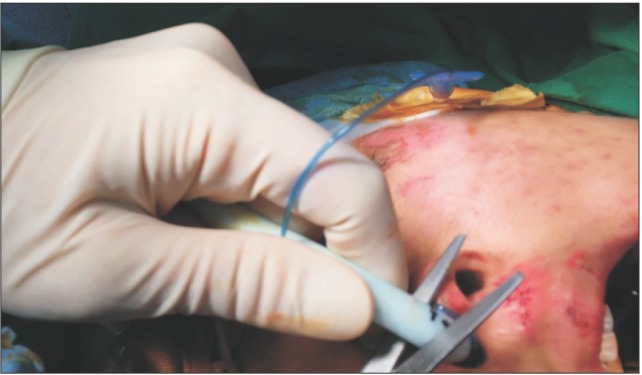J Korean Assoc Oral Maxillofac Surg.
2014 Oct;40(5):250-252. 10.5125/jkaoms.2014.40.5.250.
A simple method of intraoperative intubation tube change
- Affiliations
-
- 1Department of Oral and Maxillofacial Surgery, Gachon University Gil Medical Center, Incheon, Korea. face@gilhospital.com
- KMID: 2005456
- DOI: http://doi.org/10.5125/jkaoms.2014.40.5.250
Abstract
- Nasotracheal intubation should be performed in patients with jaw fractures because maxillomandibular fixation is required. However, when there are concomitant fractures of the nose and facial bones, an intubation tube positioned at the nose makes it difficult to perform an intricate surgery. In order to overcome these problems, a variety of ways to change the position of the tube have been introduced. We describe a simple technique of switching the tube from a nasal to oral position, which was easily executed in a patient with concomitant nasal and mandibular fractures, accompanied by a literature review.
Keyword
MeSH Terms
Figure
Cited by 1 articles
-
Orotracheal intubation in a patient with difficult airway by using fiberoptic nasotracheal intubation: A case report
Hye Joo Yun, Eunsun So, Myong-Hwan Karm, Hyun Jeong Kim, Kwang-Suk Seo
J Dent Anesth Pain Med. 2018;18(2):125-128. doi: 10.17245/jdapm.2018.18.2.125.
Reference
-
1. Werther JR, Richardson G, McIlwain MR. Nasal tube switch: converting from a nasal to an oral endotracheal tube without extubation. J Oral Maxillofac Surg. 1994; 52:994–996. PMID: 8064470.
Article2. Hernández Altemir F. The submental route for endotracheal intubation. A new technique. J Maxillofac Surg. 1986; 14:64–65. PMID: 3456416.3. Martinez-Lage JL, Eslava JM, Cebrecos AI, Marcos O. Retromolar intubation. J Oral Maxillofac Surg. 1998; 56:302–305. PMID: 9496840.
Article4. Lima SM Jr, Asprino L, Moreira RW, de Moraes M. A retrospective analysis of submental intubation in maxillofacial trauma patients. J Oral Maxillofac Surg. 2011; 69:2001–2005. PMID: 21367502.5. Goldenberg D, Ari EG, Golz A, Danino J, Netzer A, Joachims HZ. Tracheotomy complications: a retrospective study of 1130 cases. Otolaryngol Head Neck Surg. 2000; 123:495–500. PMID: 11020193.
Article6. Lee SS, Huang SH, Wu SH, Sun IF, Chu KS, Lai CS, et al. A review of intraoperative airway management for midface facial bone fracture patients. Ann Plast Surg. 2009; 63:162–166. PMID: 19542879.
Article7. Bonfils P. Difficult intubation in Pierre-Robin children, a new method: the retromolar route. Anaesthesist. 1983; 32:363–367. PMID: 6614426.8. Arora S, Rattan V, Bhardwaj N. An evaluation of the retromolar space for oral tracheal tube placement for maxillofacial surgery in children. Anesth Analg. 2006; 103:1122–1125. PMID: 17056943.
Article9. Kirby RR, Gravenstein N, Lobato EB, Gravenstein JS. Airway devices and their application. In : Kirby RR, editor. Clinical anesthesia practice. 2nd ed. Philadelphia: W. B. Saunders;2002. p. 303–328.
- Full Text Links
- Actions
-
Cited
- CITED
-
- Close
- Share
- Similar articles
-
- Bicanalicular Silicone Tube Intubation after Simple Probing in Common Canaliculus Obstruction
- Orotracheal intubation in a patient with difficult airway by using fiberoptic nasotracheal intubation: A case report
- Simple Method of Silicone Tube Intubation with Pigtail Probe and Maintenance for Lacrimal Canalicular Repair
- The effect of double silicone tube intubation on surgical outcome of endonasal dacryocystorhinostomy
- Endotracheal Intubation Using Submandibular Approach for Maxillofacial Trauma Patients: Report of 2 Cases





